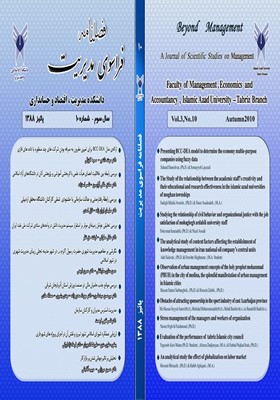ارائه ی مدل BCC-DEA برای تعیین مقرون به صرفه بودن شرکت های چند منظوره با داده های فازی
محورهای موضوعی : مدیریت بازرگانیسهند دانشور 1 , سمیه لایزالی 2
1 - استادیار و عضو هیات علمی ،واحد تبریز،دانشگاه آزاد اسلامی،تبریز،ایران
2 - دانشجوی دانشگاه آزاداسلامی واحد تبریز، باشگاه پژوهشگران جوان، ایران
کلید واژه: تحلیل پوششی داده ها, ادغام شرکت ها, شرکت های چند منظوره, داده های فازی, برش, حالت Best_Worst,
چکیده مقاله :
با پیشرفت علم و تکنولوژی، اهمیت تعیین کارایی و افزایش آن از جمله دغدغه های مهم مدیران و سرمایه گذاران است. ادغام شرکت ها در دنیای واقعی کاملاً رایج است. تصمیم به ادغام شرکت ها جهت افزایش کارایی و بهبود روند تولید و همچنین ادغام چندین شرکت تک منظوره برای ایجاد یک شرکت چند منظوره یکی از مسائل مهم در مدیریت اقتصادی است. در تعیین کارایی ادغام واحدها با روش های پارامتری همانند روش کمترین مربعات و روش رگرسیون تعیین می شد. ولی به دلیل مشکلات زیاد روش های پارامتری، روش های تحلیل پوششی داده ها (DEA) معرفی شدند. تعیین کارایی توسط مدل های مطرح شده در تحلیل پوششی داده ها از روش های بسیار پر کاربرد می باشد. این مقاله با مدل DEA مقرون به صرفه بودن ادغام DMU ها را برای تشکیل یکDMU چند منظوره با داده های فازی و غیر دقیق تعیین می کند. بدین ترتیب در زمینه اقتصادی کمک شایانی به مدیران می کند.
Among the four economy markets, the labor market plays a pivotal role in establishing relations between supply and demand as well as in balancing the mass economic variables like employment. The socio-economic consequences of the balance in labor market are of great importance for economists and policy makers. A direct consequence of such balance is the prevention of costs waste resulting from unemployment. Employment is a significant parameter in economic development, income distribution, and human self-esteem. On the contrary, unemployment causes a number of abnormalities with a wide range of economic, social and political aftermaths. Governments also consider unemployment as an important economic phenomenon and try to find solutions for this problem. It is observed that all countries, whether developed or developing, come across unemployment. The population structure of Asian countries and a great number of labor forces and lack of proper facilities have made unemployment the most important socio-economic problem. Globalization tends to influence the labor market structure, and (un)employment. As the developing countries play roles in labor market, they should be considered as an effective variable in the labor market.
Baumol, W. J., J. C. Panzar, and R. D. Willig (1982), Contestable Markets and the Theory of Industry Structure. New York: Harcourt Brace Jovanovich.
Charnes A, Cooper W.W, Rhodes E, (1978), Measuring the efficiency of Decision
Khoshfetrat, S. (2007). Determining the Efficiency of Decision-Making Units Located on Weak Frontiers in the Basic Models of Fuzzy DEA, (In Persian).
Layazali, S. (2009). Presentation of the BCC-DEA Model for Determining the Cost-Efficiency of Multi-Purpose Companies. The 2nd International Conference on Research in Operations, (In Persian).
Making Units, European Journal of Operational Research 2(6), 429-444.
Maindiratta, A.(1990), Largest Size-Efficient Scale and Size Efficiencies of Decision-Making Units in Data Envelopment Analysis, Journal of Econometrics 46, 39_56.
Ray, S. C., (2004), Data Envelopment Analysis Theory and Techniques for Economics and Operations Research, New York.
Guo, P., & Tanaka, H.(1998),Extended fuzzy DEA, in: Proceedings of the 3rd Asian Fuzzy Systems Symposium, 517–521.
Guo, P., & Tanaka, H.(2001), Fuzzy DEA: a perceptual evaluation method, Fuzzy Sets and Systems, 119, 149-160.
Kao, C., & Liu, S. T.(2000), Fuzzy Efficiency Measures in Data envelopment Analysis, Fuzzy Sets and Systems, 113, 427-437.
_||_
Baumol, W. J., J. C. Panzar, and R. D. Willig (1982), Contestable Markets and the Theory of Industry Structure. New York: Harcourt Brace Jovanovich.
Charnes A, Cooper W.W, Rhodes E, (1978), Measuring the efficiency of Decision
Khoshfetrat, S. (2007). Determining the Efficiency of Decision-Making Units Located on Weak Frontiers in the Basic Models of Fuzzy DEA, (In Persian).
Layazali, S. (2009). Presentation of the BCC-DEA Model for Determining the Cost-Efficiency of Multi-Purpose Companies. The 2nd International Conference on Research in Operations, (In Persian).
Making Units, European Journal of Operational Research 2(6), 429-444.
Maindiratta, A.(1990), Largest Size-Efficient Scale and Size Efficiencies of Decision-Making Units in Data Envelopment Analysis, Journal of Econometrics 46, 39_56.
Ray, S. C., (2004), Data Envelopment Analysis Theory and Techniques for Economics and Operations Research, New York.
Guo, P., & Tanaka, H.(1998),Extended fuzzy DEA, in: Proceedings of the 3rd Asian Fuzzy Systems Symposium, 517–521.
Guo, P., & Tanaka, H.(2001), Fuzzy DEA: a perceptual evaluation method, Fuzzy Sets and Systems, 119, 149-160.
Kao, C., & Liu, S. T.(2000), Fuzzy Efficiency Measures in Data envelopment Analysis, Fuzzy Sets and Systems, 113, 427-437.


